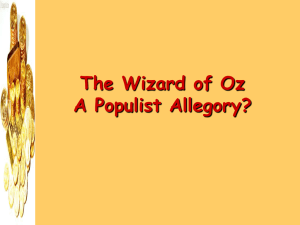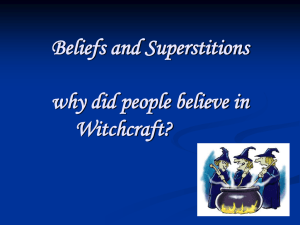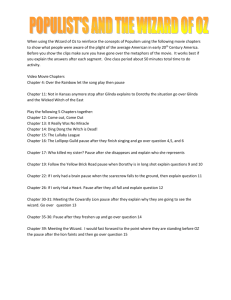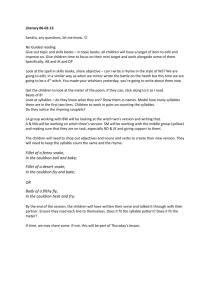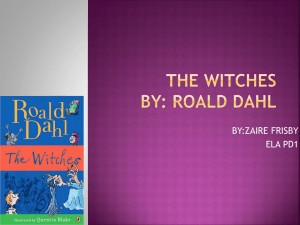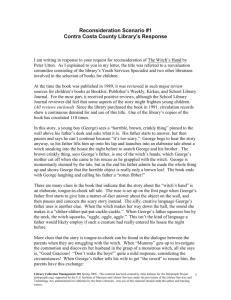proposal sample 2
advertisement
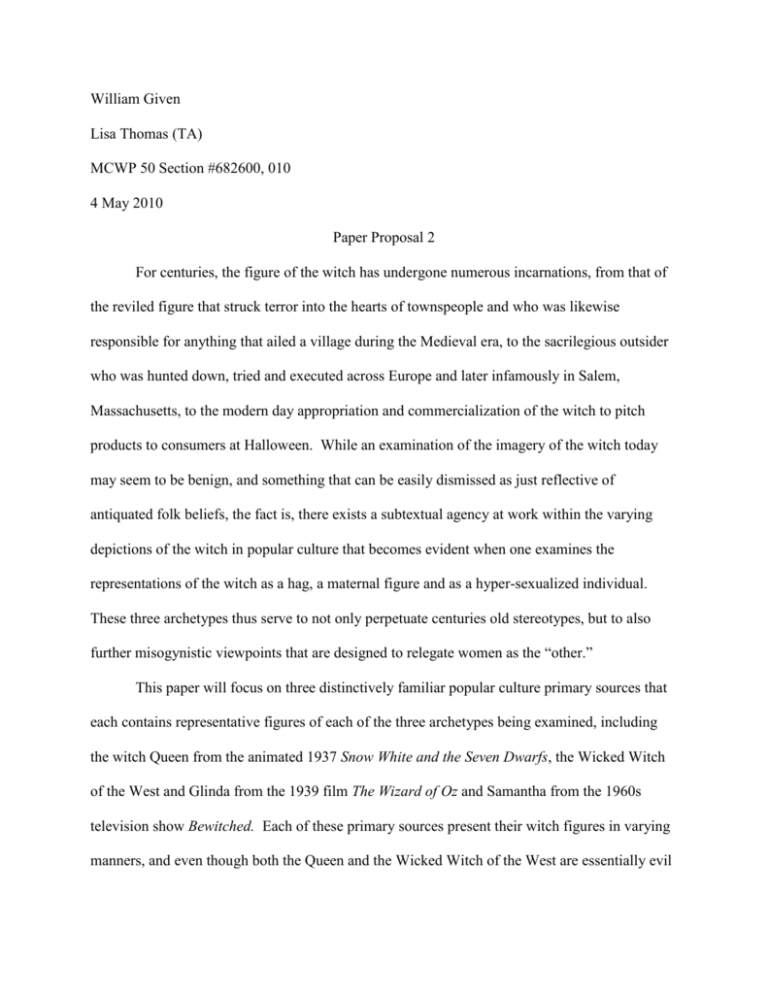
William Given Lisa Thomas (TA) MCWP 50 Section #682600, 010 4 May 2010 Paper Proposal 2 For centuries, the figure of the witch has undergone numerous incarnations, from that of the reviled figure that struck terror into the hearts of townspeople and who was likewise responsible for anything that ailed a village during the Medieval era, to the sacrilegious outsider who was hunted down, tried and executed across Europe and later infamously in Salem, Massachusetts, to the modern day appropriation and commercialization of the witch to pitch products to consumers at Halloween. While an examination of the imagery of the witch today may seem to be benign, and something that can be easily dismissed as just reflective of antiquated folk beliefs, the fact is, there exists a subtextual agency at work within the varying depictions of the witch in popular culture that becomes evident when one examines the representations of the witch as a hag, a maternal figure and as a hyper-sexualized individual. These three archetypes thus serve to not only perpetuate centuries old stereotypes, but to also further misogynistic viewpoints that are designed to relegate women as the “other.” This paper will focus on three distinctively familiar popular culture primary sources that each contains representative figures of each of the three archetypes being examined, including the witch Queen from the animated 1937 Snow White and the Seven Dwarfs, the Wicked Witch of the West and Glinda from the 1939 film The Wizard of Oz and Samantha from the 1960s television show Bewitched. Each of these primary sources present their witch figures in varying manners, and even though both the Queen and the Wicked Witch of the West are essentially evil Given 2 characters, they still are found within the context of children’s movies and are thus perceived to only be archetypal within the confines of the film itself and not representative of any underlying gendered issues, just as Samantha exists solely within a stock sitcom and is therefore perceived to be nothing more than a comedic character. The fact is, though, when juxtaposing each of these characters against secondary sources describing the trial and persecution of witches, as well as the rhetoric that was written about them at the time, the argument that each of these characters serve as extensions of misogynistic viewpoints will become evident. It is for this reason that I will be focusing on secondary sources that will not deal mainly with the primary sources themselves, such as those rooted solely in cinematic history, but rather will be centered on how these three archetypes, and the misogynistic connotations that are associated with each, were first established and have thus become part of a collective conscious on the interpretation of the figure of the witch. Beginning chronologically with Snow White and the Seven Dwarfs, the character of the Queen can be seen to be representative of all three archetypes, for at varying points within the film she embodies that of the hag, the maternal and the hyper-sexualized figure of the witch. What becomes most important though in examining this character is her relationship with Snow White herself, for the Queen, as step-mother, becomes indicative of what Robin Briggs calls in his book Witches and Neighbors: The Social and Cultural Context of European Witchcraft, the “bad mother,” or someone who is subverting a presupposed gendered role and operating in opposition to convention. The Queen wants to destroy her step-daughter based on jealousy and envy, and speaking in parallel with this is the stereotypical notion that issues such as beauty are central to a female character’s persona. There is no King depicted in the film, but rather the Queen exists as a woman who has ultimate power and therefore is depicted as being evil, or an Given 3 “outsider,” and in the process becomes the antagonist that audiences are encouraged to root against. This similar representation of the fear of women in power will be seen in The Wizard of Oz, where now the figure of the witch has been split into a binary, with The Wicked Witch of the West assuming the mantle of the Queen in Snow White and the Seven Dwarfs, and Glinda taking on the role of the dutiful mother. The Wicked Witch of the West, like the Queen, has ultimate power, living as a single woman in her castle, and feared by those who inhabit the land. Glinda though is beautiful, helpful and nurturing to the motherless Dorothy, becoming a surrogate mother figure for her and serving to teach and guide her along her journey of self-discovery. These characters further echo the misogynistic beliefs that Briggs discussed in his book, that women, who usurped traditional gendered roles and went against a maternal nature, would instantly be labeled as “wicked.” Likewise, Glinda, the maternal, is given the moniker of “Good Witch” for subscribing to the gender roles. Drawing upon this though, and bringing in Reid Davis’s article, “What WOZ: Lost Objects, Repeat Viewings, and the Sissy Warrior,” a further claim will be made that the gender roles in The Wizard of Oz exist in reversal, with the Wizard being a charlatan with no real power, especially in relation to the Wicked Witch of the West, and the fierce, warrior lion being reduced to that of a sissy. These juxtapositions of the normative, which only exist “over the rainbow,” will be the impetus then for Glinda to lead her subordinate Dorothy into an understanding of her role in society as viewed through a lens distorted by misogyny. The paper will then move forward to the 1960s and the burgeoning struggle for women to break free from their 1950s stereotypes by examining a 1964 episode of the television show Bewitched entitled “The Witches are Out.” Dealing primarily with identity, what becomes of Given 4 interest here though is how Samantha, a beautiful and hyper-sexualized, and all-powerful witch, readily takes on a submissive and subservient role to her husband. In this episode, Samantha is seen as a stereotypical Cold War era wife, always dressed in miniskirts as she does household chores, waiting patiently for Darrin to come home. This depiction of the witch in a pop culture medium serves as a devolvement of that which was presented in Snow White and the Seven Dwarfs and The Wizard of Oz and, in essence, is designed to ultimately strip away the power and the influence of the female witch to establish a male-centric power dynamic. To help strengthen this example, I believe it will be necessary to bring in secondary sources that, while not directly focusing on the imagery of the witch, speak to the roles that women have been forced to assume, such as is presented in Simone de Beauvoir’s 1949 book, La Deuxième Sexe, where de Beauvoir asks, “Qu’est-ce qu’une femme?” [What is a woman?], thus questioning the role that women have been expected to play in society in regard solely to their sex, and seeing how the constraints put on women further serve to fracture the true realization of self, just as the figure of the witch that appears all powerful in Snow White and the Seven Dwarfs, becomes split in The Wizard of Oz, and then finally is completely diluted to a non-threatening caricature based singly on the male fantasy with Samantha in Bewitched. An area that has not been researched yet, but that could prove to be invaluable to the core argument of the paper, is that of interpreting each of the primary sources through a lens of new historicism. For instance, how do the film adaptations of the Queen, the Wicked Witch of the West and Glinda, who were each originally found in literature from the late nineteenth and early twentieth centuries, compare to the suffrage movement that was taking place at the time? Likewise, how is Samantha representative of the idea of womanhood in a post-Eisenhower era America? By putting each primary source into conversation with not only the secondary sources Given 5 on witchcraft and the persecution of witches, but also with the cultural era in which each is found, a stronger connection to the belief that the characters are misogynistic projections could be achieved. This approach could also tie in nicely with the fact that each of these primary sources are aimed specifically at a younger demographic, thus allowing for the continuation of the cyclical nature of the interpretation of the archetypes of the witch. In the end, this paper will draw upon its secondary sources to establish the claim that the image of the witch that has existed for centuries has now been fractured into that of the hag, the maternal and the hyper-sexualized. These archetypes are readily apparent in specific modern popular culture references as exemplified by the three primary sources this paper will utilize and, in essence, have established new stereotypes for the figure of the witch. While originally the paper was going to focus solely upon this simplification of the archetypal examples, through the process of conducting research it was discovered that the strongly misogynistic tones that are evident on both subtextual, as well as overt, levels and the ensuing genderization of the witch is of even greater significance, and it is with that discovery that the paper has taken on its present form. These primary sources will also serve to illustrate the fact that by unfortunately setting up examples in popular culture mediums where women of power are deemed to be “evil,” “wicked,” or “outsiders,” and that the correct way to behave is by being a “good mother/witch,” or “dutiful wife,” especially in programming that is aimed at a younger demographic, the misogynistic views of the witch that rose to prominence in Medieval Europe are still very much alive today.
